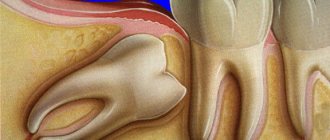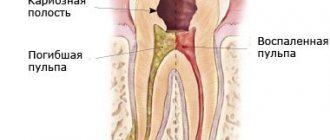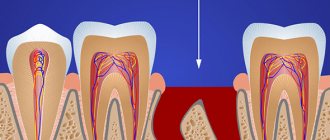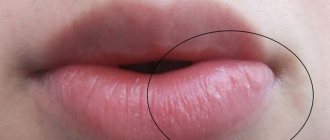What is tooth flux?
Flux, or, in dentist's language, periostitis, is a very unpleasant pathology, which is characterized by inflammation of the periosteum and soft tissues. The causes of flux on the gums can be different: trauma, gum disease, poor-quality dental treatment - all this can lead to a complication in the form of periostitis. The localization of the disease does not depend on the area of the jaw: flux of the upper and lower teeth occurs equally often.
Flux under a tooth (or above a tooth, if we are talking about the upper jaw) visually resembles an inflamed sac. However, this is far from the only possible manifestation of periostitis. There is also a serous form, when the periosteum becomes inflamed as a result of trauma and damage, as well as one of the most unpleasant types - diffuse, when the infection is localized in different parts of the jaw, which requires extensive surgical intervention with the participation of a maxillofacial surgeon.
Symptoms of gumboil
Flux on the gums in adults occurs much more often than in children (approximately 80-90 percent of all cases). A characteristic feature of the pathology is that it does not go unnoticed. This is one of the most unpleasant diseases, causing severe discomfort. The most striking symptoms are the classic purulent flux.
Symptoms
- Severe throbbing pain.
- Inflammation and swelling of soft tissues. At the advanced stage, the side of the face on which the flux is diagnosed swells.
- Enlarged lymph nodes.
- Discomfort and pain when eating and talking.
- Flux of the lower tooth (in the molar area) can lead to numbness of the lip and part of the chin.
- Weakness, headache, fever.
Signs of a tumor that is not dangerous to health
- swelling of the gums and cheeks does not increase and does not have a pronounced form;
- after removing a tooth that caused severe pain, or a wisdom tooth, discomfort and pain should gradually subside;
- even if during the removal procedure you had a slight fever, it should no longer be present, and in no case should it rise;
- there is no unpleasant odor from the hole, which may occur in case of complications.
The cheek tumor can reach its maximum size the day after tooth extraction. Then the swelling should subside.
How many days does tooth flux last?
Waiting for the flux to disappear on its own is, to say the least, naive. Some patients believe that if the flux bursts and pus comes out of the wound, then further treatment may not be carried out at all. This is a big mistake, since complete removal of pus requires special drainage, as well as complex therapy and subsequent treatment in the dentist’s chair. With timely and correct treatment, the flux disappears on average in 12-14 days; rehabilitation after severe periostitis can take more than a month.
Treatment methods
The attending physician should tell you after the examination how to treat gumboil and what measures need to be taken to achieve a successful result. The mechanism is approximately the same, but each clinical case has its own nuances. Today, several techniques are used aimed at eliminating the disease and its manifestations. As a rule, they come together.
Antibiotics for gumboils
Antibiotic treatment is an important stage of rehabilitation. The most effective antibiotics for fighting inflammation and infection are Metronidazole, Lincomycin, Amoxiclav and their analogues. Any tablets and antibiotics for tooth flux should be taken only as prescribed by a doctor!
Physiotherapy
Used as an additional measure to reduce inflammation and speed up recovery. Recommended procedures include electrophoresis, laser and ultrasound therapy.
Therapeutic treatment
It is carried out if it is decided to save the tooth. This includes endodontic treatment and filling of root canals, as well as resection of the root apex if necessary. If the cause of the flux is periodontitis, then a series of manipulations are carried out to eliminate the accumulation of bacteria in the periodontal pockets.
Surgical procedures
This includes tooth extraction and periostotomy - the main procedure for treating flux. The doctor makes an incision into the purulent sac, and then installs a drain through which the purulent exudate comes out.
Local therapy and rinsing for tooth flux
For better release of pus, pain relief and reduction of swelling, gels and ointments are used topically: Metrogyl Denta, Levomekol, Cholisal. Many people are interested in how to rinse gumboil on the gums. Miramistin and soda solution are usually used for rinsing. As an alternative, you can use folk remedies: decoctions and tinctures of propolis, chamomile, sage or calendula. A tooth after gumboil is still very vulnerable: to minimize the risk of re-infection, these treatment and preventive procedures are very important.
How to treat swollen gums, how to relieve swelling
Before taking any action, you need to determine the cause of the swelling (edema). This is important, since treatment tactics will be different in each case and those actions that are necessary in some cases may cause a worsening of the condition in others.
Exacerbation of periodontitis
Symptoms
Periodontitis is an inflammatory process in the bone associated with infection entering the root canals of the tooth and its further spread into the bone. In conditions of decreased immunity (against the background of acute respiratory infections, seasonal cold snaps, severe general diseases), inflammation in the bones can go from chronic to the acute stage, which is accompanied by an increase in the amount of pus. As a result, pain and swelling appear on the gums. Periodontitis can occur either in a previously untreated tooth or in an already treated tooth with filled canals (if the canals have not been cleaned somewhere or additional canals have not been found).
With an exacerbation of chronic periodontitis, the following symptoms may occur (not necessarily all, there may only be some from the list):
- swelling of the gums in the area of the causative tooth;
- The swelling is small at first, but it increases over time, the mucous membrane becomes more “tense”, after a while a fistula may appear - a white bubble against the background of swelling. The fistula opens over time, pus flows out, and the swelling gradually decreases;
- pain when pressing on the gum with a finger and/or when biting on a tooth;
- the causative tooth does not respond to cold, warmth, or sweets;
- a carious cavity in the tooth (or, if the tooth has been previously treated, a large filling);
- possible increase in body temperature.
Pain and swelling with periodontitis appear due to the accumulation of pus, as soon as the pus is released (through the fistula - if without treatment, or through the root canals - if the patient went to the dentist), the pain goes away.
If the fistula has opened, the swelling has gone away, and there is no more pain, this does not mean that the problem is solved. There is still an inflammatory process in the bone and you need to see a dentist.
How is periodontitis treated in the acute stage?
It is necessary to consult a doctor to clarify the diagnosis. The dentist will take an x-ray to determine the location of the inflammatory process and its size. In the future (depending on the location of the process and its size), the doctor can offer three options for further action:
- Conservative treatment is dental treatment that creates an outflow of pus through the root canals, followed by filling.
- Surgical treatment – tooth extraction and cleaning of the socket.
- Combined treatment (if there is already a large tumor, but the tooth is planned to be saved) - the tooth is treated and an antiseptic is applied under a temporary filling, and at the same visit a loosening incision is made through which the pus will come out.
Which method will be used and in what case is decided by the dentist. The treatment method depends on the location and size of the process, the condition of the tooth, further possible prospects for tooth restoration, general health and many other factors.
In parallel with each of these interventions, procedures that need to be carried out at home can be prescribed:
- rinsing with a soda-salt solution (1 teaspoon of soda and salt per glass of water);
- taking antibiotics (most often lincomycin 0.5 grams 3 times a day – 5-7 days);
- anti-inflammatory drugs (most often nimesil - 1 packet 2 times a day for 3 days).
What to do before the patient can see the dentist?
- Do not warm the swelling area under any circumstances (do not apply heat, do not apply anything);
- soda-salt rinses (the more often the better - about 10 times a day);
- anti-inflammatory drugs (nimesil);
- You should not start taking antibiotics without a doctor’s prescription - you may end up with a blurred picture of the process and the doctor will not be able to decide on the correct treatment tactics in this case;
- Painkillers and anti-inflammatory drugs should not be mixed. If you have chosen one drug, then you do not need to take others at the same time - this can be dangerous to health and even life.
Acute gingivitis, exacerbation of periodontitis (gingivitis)
Causes
Gingivitis is inflammation of the gums, periodontitis is inflammation of the gums involving bone tissue. These processes occur only in the tissues surrounding the tooth, without affecting it. With gingivitis and periodontitis, the teeth themselves usually do not bother (except in cases of parallel progression of gum disease and dental disease). There are many causes of gingivitis (most often it is tartar, untreated carious cavities, incorrectly installed fillings and orthopedic structures, and bite characteristics). Gingivitis can be acute or worsened chronic; periodontitis most often has a chronic course with periods of exacerbations. Exacerbation may occur due to the following factors:
- injury to the gums with sharp objects (cuts, punctures with fish bones)
- foreign bodies in periodontal pockets (chipped tartar, bones, fibrous food)
- acute respiratory infections, acute respiratory viral infections, other systemic diseases,
- frequent exacerbations of gingivitis in diabetes, diseases associated with decreased immunity,
- taking drugs that reduce immunity (corticosteroids and others).
Symptoms
With gingivitis in the acute stage, the following are observed:
- pain and swelling of the gums near a group of teeth (localized gingivitis) or the entire jaw (generalized gingivitis);
- pain when brushing teeth and eating;
- bleeding gums at the slightest impact (brushing teeth, eating hard foods);
- the gums are red, sometimes bluish;
- possible reaction to hot food;
- pain when pressing on the gum;
- the teeth are partially covered by swollen gums.
With periodontitis, these symptoms are similar and the difference will be that with gingivitis there are no radiological changes in the bone, but with periodontitis there will be a decrease in the height of the interdental septa and their pattern is not clear. Also, with periodontitis, exposure of the roots of the teeth is observed, but in the acute stage, due to edema, the roots can be covered with soft tissue.
Treatment
Gingivitis and periodontitis also need to be treated by a dentist.
The following events are held in the office:
- removal of hard and soft dental plaque (possibly using anesthesia), polishing the surface of the teeth and exposed roots;
- correction of fillings, removal of traumatic elements of orthopedic structures;
- removal of foreign bodies, if any are found;
- treatment of the oral cavity with antiseptic solutions;
- applying anti-inflammatory drugs under the bandage;
- in severe cases, patch surgery may be required - exfoliation of gum tissue, cleaning of teeth, roots, bone from stone and affected tissue, followed by suturing.
In combination with this, antibiotics, anti-inflammatory drugs, painkillers, and antiseptic rinses can be prescribed.
Before you have the opportunity to visit the dentist, you can take the following measures:
- rinsing with a soda-salt solution (1 teaspoon of soda and salt per glass of water) and antiseptic solutions (chlorhexidine, furatsilin - according to the instructions);
- Be sure to brush your teeth. They use anti-inflammatory pastes and pastes to relieve bleeding gums (Paradontax, Lakalut Active, Thebodont and others), it is advisable to use thread;
- treating the gums with anti-inflammatory drugs (the most famous is Metragil Denta) 3 times a day, after brushing the teeth and rinsing;
- if it hurts to brush your teeth, you can treat the gums with an anesthetic before brushing (Dentol and other products used in babies when teething).
If after 2-3 days there is no improvement, then you need to consult a doctor, since gingivitis can become chronic or the situation may worsen - the formation of an abscess.
Periodontal abscess
An abscess is a localized area of inflammation characterized by the accumulation of pus under the gum. In fact, this is a cavity filled with pus, which looks like a hemispherical formation on the gum. The size of an abscess can reach the size of a walnut.
Causes
The causes of periodontal abscess can be different, but the most common are:
- release of pus from chronic periodontitis in the acute stage;
- accumulation of pus due to periodontitis;
- deep trauma with a foreign object, in which the infection entered deep into the tissue (an injection with a fish bone, in which a piece of bone remained in the gum, for example).
Symptoms
- A convex semicircular formation in the gum;
- when pressing, pain, elastic tense tissues, a symptom of fluctuation (when pressing on the formation, the movement of fluid inside is felt);
- swelling of surrounding tissues;
- swelling may spread to the cheeks, causing facial asymmetry;
- possible increase in body temperature.
Treatment
Treatment of an abscess in Samara depends on the cause of its appearance. If it develops as a result of injury (as in the case of a bone), then the treatment is exclusively surgical - opening the abscess, removing purulent contents, installing drainage. If the cause is periodontitis or periodontitis, then measures are taken in parallel to treat the causative disease.
After surgery, antibiotics, painkillers, anti-inflammatory, antihistamines are prescribed, and after 3-4 days, when the swelling subsides and the drainage is removed, epithelializing drugs are also prescribed. This treatment is prescribed by a doctor.
Need to know:
- If you notice symptoms similar to an abscess, you should immediately go to the doctor. Delaying treatment can lead to the formation of phlegmon - diffuse inflammation, which usually ends with cuts on the outside of the face, and can also lead to sepsis - blood poisoning.
- Inflammatory processes should not be heated. When heated, microorganisms multiply more actively, and this can also lead to rapid progression of the process.
Is a tooth removed during gumboil?
A tooth can be removed due to flux, but in modern dentistry the emphasis is on tooth-preserving manipulations. This also applies to flux. A tooth must be removed when its crown is seriously damaged and cannot be restored with a pin or inlays. If an infection occurs under the crown, then re-prosthetics are often difficult. In some cases, a tooth has to be removed because it is impossible to unfill the canals after a previous unsuccessful treatment, but this happens extremely rarely. In any case, the doctor makes the decision to remove a tooth based on the clinical picture.
Why is tooth flux dangerous?
An inflammatory process of this type tends to develop and, as it spreads, affects deeper layers of tissue. If left untreated, flux often develops into phlegmon - a serious purulent inflammation that has no definite boundaries. The most severe forms of flux provoke the development of sepsis, which can lead to infection of the entire body and even death. It is important not only to know how to cure gumboil and visit the dentist on time, but also to follow a number of preventive measures so that the likelihood of complications developing is minimal.
- Regular and high-quality hygiene.
- Treatment of caries at the initial stage. Flux, dental cysts and other complications often arise due to untreated pulpitis and periodontitis.
- Preventative visits to the clinic to assess the condition of the oral cavity and carry out professional cleaning.
Inflamed gums: causes of the disease
The causes of inflammatory processes in the gums are external and internal. External ones include:
- Damage to the gums when brushing your teeth with a hard brush;
- Trauma from solid food;
- Accidental injury with a toothpick;
- Various dental diseases;
- Receiving microtrauma when installing braces or dentures;
- Insufficient or incorrect oral hygiene.
The internal reasons for which the gums become swollen and painful are “systemic failures” in the body:
- Diseases of internal organs or entire systems - gastrointestinal, cardiovascular, endocrine, etc.
- Immunodeficiency, hereditary diseases;
- Chronic vitamin deficiency;
- Reaction to medications;
- Pregnancy.
Any of these reasons can cause gum diseases such as gingivitis, periodontitis, and periodontal disease.










